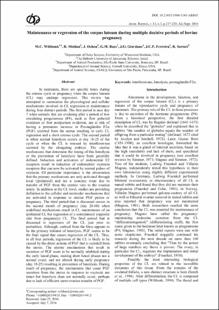Mechanisms for rescue of corpus luteum during pregnancy: gene expression in bovine corpus luteum following intrauterine pulses of prostaglandins E1 and F2α
...
Baez, Giovanni | 2017-12-27
In ruminants, uterine pulses of prostaglandin (PG) F2α characterize luteolysis, while increased PGE2/PGE1 distinguish early pregnancy. This study evaluated intrauterine (IU) infusions of PGF2α and PGE1 pulses on corpus luteum (CL) function and gene expression. Cows on day 10 of estrous cycle received 4 IU infusions (every 6 h; n = 5/treatment) of saline, PGE1 (2 mg PGE1), PGF2α (0.25 mg PGF2α), or PGE1 + PGF2α. A luteal biopsy was collected at 30 min after third infusion for determination of gene expression by RNA-Seq. As expected, IU pulses of PGF2α decreased (P < 0.01) P4 luteal volume. However, there were no differences in circulating P4 or luteal volume between saline, PGE1, and PGE1 + PGF2α, indicating inhibition of PGF2α-induced luteolysis by IU pulses of PGE1. After third pulse of PGF2α, luteal expression of 955 genes were altered (false discovery rate [FDR] < 0.01), representing both typical and novel luteolytic transcriptomic changes. Surprisingly, after third pulse of PGE1 or PGE1 + PGF2α, there were no significant changes in luteal gene expression (FDR > 0.10) compared to saline cows. Increased circulating concentrations of the metabolite of PGF2α (PGFM; after PGF2α and PGE1 + PGF2α) and the metabolite PGE (PGEM; after PGE1 and PGE1 + PGF2α) demonstrated that PGF2α and PGE1 are entering bloodstream after IU infusions. Thus, IU pulses of PGF2α and PGE1 allow determination of changes in luteal gene expression that could be relevant to understanding luteolysis and pregnancy. Unexpectedly, by third pulse of PGE1, there is complete blockade of either PGF2α transport to the CL or PGF2α action by PGE1 resulting in complete inhibition of transcriptomic changes following IU PGF2α pulses.
LEER











